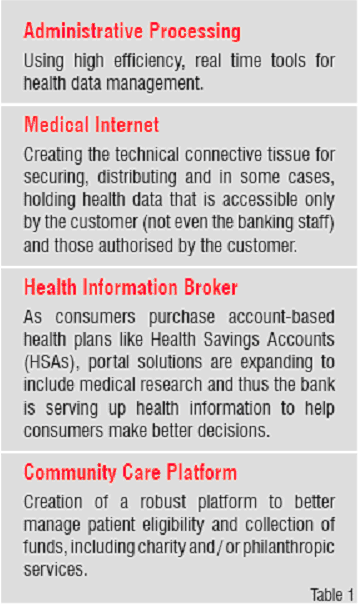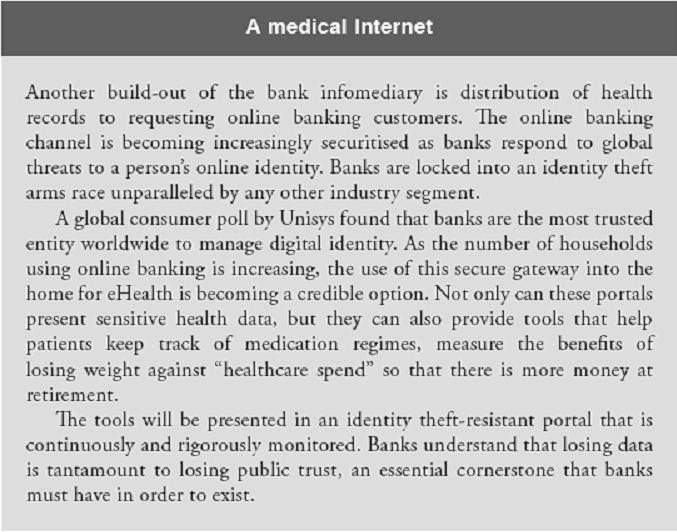
As the management of healthcare data progressively moves to an electronic platform, banks are realising that their technical systems, privacy and security frameworks, identity management engines and marketing channels can be leveraged to fast forward e-Health.
For many years, banks have been considered as "money changers" that apply their trade in between the healthcare stakeholders. The emergence of privacy and security mandates like Health Insurance Portability and Accountability Act (HIPAA), coupled with the growth of account-based health plans, increasingly managed by banks, is challenging this paradigm. Banks are starting to throw off the mantle of back-room payment processing agent to take on a more active role in health data management. This area, called "medical banking", may be defined as the latent integration of banking technology, infrastructure and credit with healthcare administrative operations.
In healthcare, major banks are rescoping their role from offering funds management to becoming a value-added data hub in between stakeholders-a bank infomediary. This is evolving in four key areas (See Table 1).

The banking industry's response to a global matrix of privacy and security regulations has resulted in the creation of cross-industry, feature-rich, data processing platforms. Global compliance morph has led to increasing layers of security within this platform like multi-factor authentication. Bankers, ever risk-averse, aren't readily willing to engage new services. Yet, even the most conservative among them will admit that the twin impact of privacy regulations and consumer-driven healthcare has levied a broad impact on traditional banking. These drivers have opened new doors for bank and non-bank competitors, forcing traditional banks to defend their payment franchise. Essentially, a red carpet has been rolled out for banks to enter the highly inefficient administrative domain in healthcare.
As banks wrestle with return on investment for complying with a global matrix of data privacy regulations, they have had to make hard business decisions about whether to serve or exit the existing market. These facts set the table for the first axiom in medical banking: as compliance laws escalate in the digitisation of health data, banks will increasingly specialise their portfolio of healthcare services.
An example of this is Bank of New York Mellon (BNY). The bank is implementing a pilot accreditation programme developed at the Medical Banking Project that will give it a "Gold Seal" in the area of privacy and security. Alongside this effort, BNY Mellon entered into an alliance with a national claims clearinghouse, SSI Group that provides services to over one third of US hospitals. The organisation intends to reduce transaction costs in healthcare, leverage marketing channels and create new medical banking services.
Thus, the substantive engines that banks own for data processing, security systems, identity management and formidable marketing arsenal, are now used to streamline healthcare costs and to create demand for new products and services. Compliancy across industries and geographies invokes not just HIPAA, Gramm Leach Bliley (GLB), Fair and Accurate Credit Transactions Act (FACTA) and other US laws but the European Directive on Data Protection and other overseas laws as well. As a result, banks have developed geographically seamless and compliant platforms that can host new eHealth tools as a natural product evolution.

Developing services that link cash management with claims clearinghouses is an area that is in full swing today. Major banks have announced new healthcare relationships. Traditional stakeholders are finding highly capitalised banks sitting at the table, actively participating in legislative efforts and making an increasing number of health information technology acquisitions. This market dynamic leads to a second axiom in medical banking: Banks will increasingly invest in healthcare IT, leading to broader adoption of electronic healthcare services as banks exercise economy of scale.
As banks use their power to distribute new services, the services themselves are transforming both in terms of tighter integration with claims processes and cost point. This will tend to increase the number of physicians using electronic claim services, expedite claims-to-payment and even affect the very structure of health data transactions.
In fact, traditional healthcare groups are already inviting banks to sit on workgroups to learn how to make claims processing work seamlessly (i.e., National Council for Prescription Drug Programs (NCPDP), Workgroup for Electronic Data Interchange (WEDI)).
A major product innovation today focusses on using a bank's computational and imaging capability, embedded in mail transport systems, to proactively secure payments, reconcile payments with bank accounts, categorise denial and / or adjustment reason codes and present claim images within a logical, computer-assisted workflow. Loosely configured services on a banking platform are becoming tightly linked with health data partners to automate daily patient accounting tasks. An example of this is PNC Bank, which used a hybrid revenue platform to help a national provider save US$ 4 million in processing costs in 2006. Concomitantly, these types of platforms enable insurers to ramp providers onto a digital workflow, reducing processing costs for both parties.
The "hybrid revenue platform" can also streamline front-end processes. Imagine going to a kiosk at a retail clinic (Wal-Mart, CVS), typing in your ID just like using an ATM, and gaining immediate access to your HSA / HRA records, making payments (which are automatically reconciled and posted onto the provider's system), pulling down healthcare records and forwarding your current demographics, so you don't have to fill out those forms over and over again. Variations of this type of a product are being tested in US markets and it's not hard to imagine that they will become a global model, especially as medical tourism takes flight necessitating on-demand access to health records and health accounts.
More consumers are turning to the Internet for basic healthcare research. Coupled with market demand for digital tools, banks are increasingly linking to health data sources. As they do this, banks may team with well-known brands in the academic world, pharmaceutical manufacturers and others. These organisations will provide high quality, easy to understand information to bank customers. A special feature of this service will enable personalisation and automation of research, "e-clipping" data that an online banking consumer may want for future reference.
Medical banking holds the potential of shaping a broader understanding of "human capital". This area offers a value-centred view of healthcare as opposed to focussing on cost alone. In this line of reasoning, banks will seek to provide quality health information to account holders for their better lifestyle decision-making. Banks that follow such rationale will retain HSA assets and tend to have larger profits. A report by Booz Allen suggests that major banks will yield over US$ 1 billion in net revenues in part by meeting this key challenge.
Banks are scoping out a broader platform to enable robust front end processing for care providers. This type of a system will be used to categorise patients that come into the emergency room, for instance, into an action-driven platform that better co-ordinates care resources in the community.
Sixty per cent or more of the people treated in high-cost emergency room settings are non-urgent cases. The platform will address this issue and make it easier to exchange data and funds between stakeholders. For a major bank that serves millions of consumers, there is a direct correlation between the health of a community and increased deposits, a mainstay in banking.
As the "health-wealth" equation evolves, banks will increasingly be viewed as a partner in quality living, linking everyday banking to the decisions we make about our lifestyle choices. The consumer will drive the bank infomediary and stretch it in the ways yet to be discovered. In the meantime, banks are investing heavily along this product pathway, creating increasingly sophisticated processing platforms that are well-suited to reduce transaction costs in healthcare.